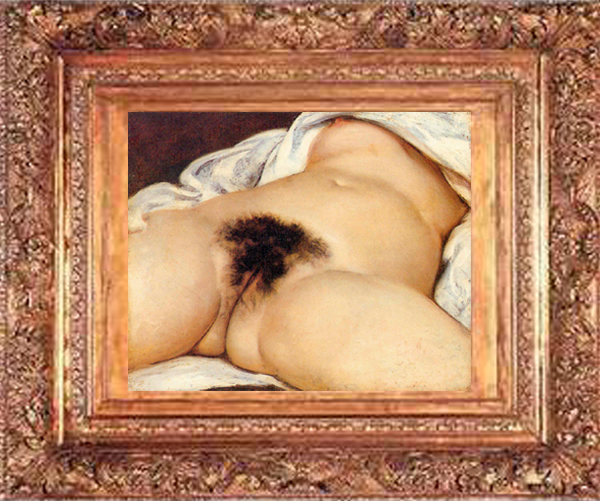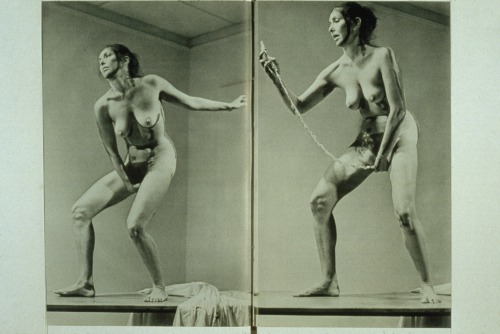
When we begin contacting Courbet’s painting reproduced above, we interpret as an image of erotic connotations and perhaps even pornographic. The making of realistic painting and its rich detailing reference to the presence of a true view and testified as fact. However, such a reading is too hasty. The correct interpretation of art always requires a time and a way: dialog with the work. So Paul Klee said: Do you understand a work? Take a chair.
Reading this image as simply erotic and “spicy” with perspective somewhat sexist, is in open opposition to the very strong Aristotelian tradition in which art is understood as a value and therefore referring to what “should be” and not exactly what it is. This tradition is unfortunately often overlooked by historians rushed, which often make the “retrospective illusion”, i.e., they believe that their own concepts can be designed throughout history. Pure realism in art is a delusion. Aristotle in his “Poetics”, distinguishes the historian, which works with what is, and the artist, which is what it should be; noting the intellectual superiority of the seeker the world as it should be, so the theoretical and metaphysical sphere. This is the first and fundamental distinction between the literary/artistic and historiography. Thus, poetry is the imitation of human action, and history is the narration of events and facts that actually occurred. The classic distinction between literature and history, based on the conventions of fictionality and truth, derives from the Aristotelian conception that poetry is imitation of human actions (“should be”), and history is the narration of the events actually occurred. Here we have already made, the structures of the modern conventions of fictionality and truth, key concepts in the definitions of the two discursive modes. It is from this distinction that we can understand the contemporary critical movement of history and fiction, which seeks a rapprochement between history and fiction, or more exactly approximation of historiography with the poetic. A good part of recent historians advocate a philosophy of history that interprets the historiography as well as belong with the literary dimension, thus behaving like something of the fiction. So today, instead of seeking the difference as Aristotle, search the similarities. For Aristotle, this difference is not only the metaphysical order, but also epistemological. The fundamental difference between the Poetics puts the History and Poetry sets up the kind of knowledge that each gender develops: (1) the poetic imitation or (2) the historical narrative. Imitation meaning what could have been (should-be), and historical narration which indeed was.
The knowledge provided by history is less than that given by poetry, because his concern is for what happened to an individual who is a minor scope of what could happen, the universal. For Aristotle the true and certain knowledge always universal aims. Only knowledge is universal rational, poetry is something more philosophical, more serious, deeper than the story.
The formal (formal cause) dimension of Poetry / Art – the confabulation plot of facts – guaranteed structuring actions perfectly organic, unitary and beautiful way (“For the beauty lies in the extent and order […] ” Poetics, VII, 1450 35 b). In the beautiful, each party has its meaning in terms of making up the whole, in such a way that results in knowledge and pleasure (final cause). The poetic imitation of the world, after that requires a certain transfiguration of a world in a coherent and organic whole.
“It is, moreover, evident from what has been said, that it is not the function of the poet to relate what has happened, but what may happen,– what is possible according to the law of probability or necessity. The poet and the historian differ not by writing in verse or in prose. The work of Herodotus might be put into verse, and it would still be a species of history, with metre no less than without it. The true difference is that one relates what has happened, the other what may happen” (Poetics, IX, 1451 b).
In Aristotle’s Poetics, Poetry is imitation (mimesis), which is characterized by an operation of representation and the transfiguration of nature (physis). In your nature the man is action. The imitation of this action does not happen in terms of simple copy or transcript, but as an expansion and the universalization of its ability. The poet imitates actions and this imitation is creation, for it goes beyond what is simply given, deriving possibilities and potentialities (poiesis). The poet is a creator of fables and should compose and recompose the traditional myths to achieve its own ends, i.e., create and broker the elements chosen in an order that leads to a significant whole. The activity of the poet is then total or universalize what is singular. Make sense of the fragmentary referring it to a significant totality.
Let us return to Courbet and started with this new data, the dialogue with the work. This is the presentation of a female sexual organ. Not a pornographic experience, despite the accurate representation and in detail. We are facing a sensory confrontation and we must wonder about their meaning. What does this painting mean? This confrontation, on the hermeneutic circle, leads us to the very experience of art, in which sensory and repertoire are mobilized to produce the need for meaning. The title of the work provides the key to its correct interpretation. Word and image, sometimes establish complicity and mutual clarifications or illustrations. One illuminates the other. Especially from the Renaissance, the title of a work can turn it into a real allegory, in Benjamin’s sense. That is, a particular feature, a certain perspective, a fragment become an expression of the whole. The particular monad is all expressed in a point of view. The title of Courbet’s work is “The Origin of the World”. Then a certain woman with her particular sexual organ, becomes an allegory of the creation of the world, the powers of the Great Mother, which is the source of all us. The painting then expressed the allegory of creation, the very power of art, artist and cultural gesture that creates a sense of something. The power of appointment. Naming means to transform the world, recreate it, transfiguring it into pure sense or meaning. We cannot help but notice that Courbet think the woman with her sexual organ as the carrier of this power to create and name. In this sense, we can, following a track Lehrer (2012), associate the work of Courbet to the performers Carolee Schneemann works that explore women’s issue and, especially, the creative dimension of women. His work “Interior Scroll” shows us the creative forces of women, symbolized by the act of generation; act materialized in sensitive way of your sex organ.
It is then to establish the links between biology and lost the sacred. In our society this link is always hidden in the objectification of ensuring the biological fetish for merchandise that becomes naturalized. For example, simply review the cartoon and children’s comic books. Social relations are always displayed as uncles and nephews. Almost there is no biological relationship of father and mother. At the same time, industrial objects as they are collected from trees, used and disposed of without any binding to its production system. A character needs a helicopter and it appears immediately on hand to be used. And after use is mysteriously dropped. Everything behaves as if it were organic products, the nature and harvested trees.
The work of Courbet and Schneemann have the strength to reveal this strange situation returning the importance for biological, for women and their specificity. Also, this biological is not presented as pure brute fact, but linked to the cultural process and a certain sacredness that celebrates the creative act, unveiling the be hiding in the art of the era. The world and all that dwells in it then becomes the result of a creative process, a system or production process.

References
– ARISTÓTELES. (1996). Poética. Trad., Pref., Introd., Com., Apend. de Eudoro de Sousa. Porto Alegre: Globo.
– Butcher, S.H.(2006). “Aristotle’s Poetics: New Translation.” 2006-08-05. <http://www.leeds.ac.uk/classics/resources/poetics/poettran.htm>
– Costa, Lígia Militz da. (1992). A Poética de Aristóteles: Mímese e Verossimilhança. São Paulo: Ática.
– Gazoni, M. F. (2006). A Poética de Aristóteles: tradução e comentários. 2006. 132 f. Tese (Doutorado em Filosofia) – Faculdade de Filosofia, Letras e Ciências Humanas, Universidade de São Paulo, São Paulo.
– Goldschmidt, Victor. (1982). Temps physique et temps tragique chez Aristote. Paris: J. Vrin.
– Lehrer, Keith. (2012). Art, Self and Knowledge. Oxford: Oxford University Press.
– Naval Durán, Concepción. (1992). Educación, Retórica y Poética: tratado de la educación en Aristóteles. Pamplona: Ed. da Universidad de Navarra.
Ph.D Eduardo Cardoso Braga
2014

Comments are always welcome. Thank you.